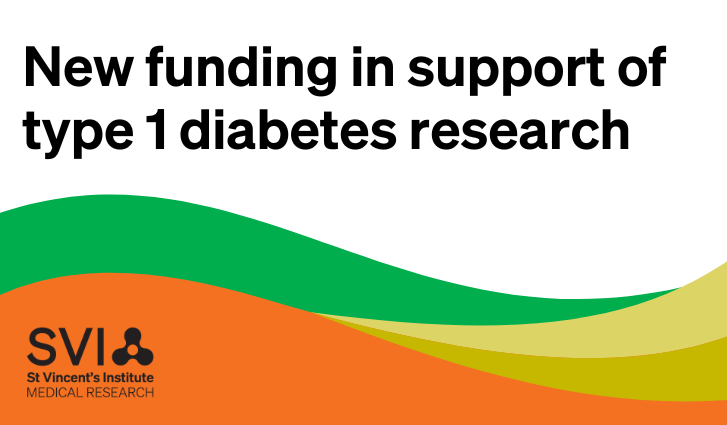The Human Immunology laboratory is focused on the autoimmune disease type 1 diabetes. Broadly, we have two goals. The first is to understand how and why insulin-producing beta cells are attacked by the immune system’s T cells – which is the ultimate cause of type 1 diabetes. Our second goal is to use this information to develop safe and effective ways to stop disease progression for people at high risk. Our long-term objective is to reverse type 1 diabetes in people who have been recently diagnosed.
Currently, the focus of our work is unravelling the specificity of the autoimmune responses that cause people to develop type 1 diabetes. We achieved a world-first when we isolated and analysed human islet-infiltrating T cells from deceased organ donors who suffered from type 1 diabetes. This invaluable resource has allowed us to understand the ‘nuts and bolts’ of the autoimmune response in the part of the body that is affected.
A second major focus is to develop and validate new tests that can be used to monitor the autoimmune response that causes type 1 diabetes. This works will lead us to develop safe and effective therapies for the prevention, or reversal, of type 1 diabetes.
Current research projects
-
Why doesn’t everyone get type 1 diabetes?
As a living tissue, blood holds the key to many mysteries about what is happening at a fundamental, molecular level in our body. It provides clues to how the body detects and identifies foreign visitors – and why sometimes, it gets it wrong and attacks itself.
We want to know what is happening at a cellular level in those people – what is their body doing differently that other people’s bodies aren’t?
To answer this question, the researchers will look at markers called human leucocyte antigens, or HLA, which everyone has on most cells of their body. Their job is to help your immune system identify your cells as your own, so that it doesn’t see them as foreign and mistakenly initiate an immune response. There are different types of HLA, but there are a few in particular the researchers would like to explore. Your blood donation will help them do that.
For more information, please see Why doesn’t everyone get type 1 diabetes?
What antigens do human islet infiltrating CD4+ T cells ‘see’?Group Leader: Associate Professor Stuart Mannering
Team Members: Dr Pushpak Bhattacharjee, Dr Matthew Lacorcia, Eleanora Tresoldi, Miha Pakusch, Abby Foster, Elizabeth Crouch
Collaborators:
- Professor Tom Kay and Associate Professor Helen Thomas
- Professor Fergus Cameron, Royal Children’s Hospital, Melbourne
- Professor Ed Stanley, Murdoch Children’s Research Institute
- Associate Professor Jason Tye-Din and Dr Melinda Hardy, WEHI
- Associate Professor John Wentworth, WEHI
- Associate Professor Dan Pellici, Murdoch Children’s Research Institute
- Professor Jamie Rossjohn and Dr Hugh Reid, Monash University
Genome wide association studies (GWAS) have confirmed that the strongest genetic risk for T1D is mediated by HLA alleles, specifically HLA DQ8 and DQ2. The second strongest association maps to the promoter region of the insulin gene. While these associations are well accepted in the field, it remains unclear how HLA DQ2/8 and insulin lead to type 1 diabetes. From our analysis of human islet-infiltrating CD4+ T cell clones we have identified several HLA DQ8-restricted CD4+ T cell epitopes derived from the C-peptide of proinsulin. This project will build upon this success and identified epitopes from other antigens (including GAD-65, IGRP, IAPP, ZnT8). The long-term goal is to identify common features of epitopes seen by islet infiltrating CD4+ cells. This project will examine the epitope’s affinity for the restricting HLA allele, the avidity of TCR binding and TCR usage.
Do islet infiltrating CD4+ T cells recognise epitopes formed by post-translational modification?Group Leader: Dr Stuart Mannering
Team Members: Vimukthi Pathiraja, Eleanora Tresoldi, Prerak Trivedi
Collaborators:
- Professor Tony Purcell and Dr Nadine Dudek, Monash University
- Dr Maki Nakayama and Dr Aaron Michels, Barbara Davis Center for Childhood Diseases (USA)
- Professor Jamie Rossjohn and Dr Hugh Reid, Monash University
- Dr Eddie James, Benaroya Research Institute (USA)
In 2005, we published the first description of an epitope formed by post-translational modification to be implicated in T1D (Mannering et al JEM 2005). While the concept of autoimmune responses against self-antigens that have undergone post-translational modification remains popular, this area remains largely unexplored in human studies.
Our panel of islet-infiltrating CD4+ T cell clones are invaluable tools that allow us to determine if these cells recognise epitopes formed by post-translational modification. Our approach is to test panels of synthetic peptides that incorporate modified amino acids and determine if any of these are recognised by islet infiltrating CD4+ T cells. To date, we have identified one HLA-DQ8 restricted epitope that is formed by post-translational modification.
Future work will screen a larger panel of peptides from other beta-cell antigens to find new epitopes formed by post-translational modification. Using our very sensitive CFSE-based proliferation assays (Mannering JIM 2003), we will measure responses to modified epitopes in PBMC from individuals with and without T1D. Our biochemical/functional analysis will also include structural analysis of TCR-peptide-HLA complex to gain insights into how human T cells ‘see’ autoantigens.
Identifying the antigens and epitopes seen by human islet-infiltrating CD8+ T cellsGroup Leader: Dr Stuart Mannering
Team Members: Prerak Trivedi and Eleanora Tresoldi
Collaborators:
- Professor Tony Purcell and Dr Nadine Dudek, Monash University
- Professor Tom Kay, Associate Professor Helen Thomas and Dr Bala Krishnamurthy
CD8+ T cells that recognise beta-cell antigen derived epitopes presented by HLA class I molecules are believed to the ‘killers’ that destroy the insulin-secreting beta cells. The goal of this project is to identify the antigens and epitopes ‘seen’ by human islet-infiltrating CD8+ T cells.
We have developed a Cos cell transfection system which allows us to screen CD8+ T cell clones for responses to individual antigen/HLA combinations. This system has been validated using CD8+ T cell clones specific for viral epitopes restricted by relevant HLA alleles. Antigens that stimulate the clones will be dissected to identify the epitope(s) and HLA restriction. This information will be used to generate HLA tetramers for characterising beta cell antigen specific CD8+ T cells in human peripheral blood.
Identifying the antigens and epitopes seen by human islet-infiltrating CD8+ T cellsGroup Leader: Dr Stuart Mannering
Team Members: Eleanora Tresoldi
Collaborators:
- Dr Nadine Dudek, Monash University
- Dr Bala Krishnamurthy
Identification of antigens recognised by human T cells has been technically challenging. This is because relevant T-cell clones have been difficult to isolate and preparing antigen in a suitable format has been difficult. Hence the aim of this project is to develop improved techniques for identifying antigens recognised by human islet infiltrating T cells.
We propose to genetically fuse the antigens to the Class II invariant chain that directs the protein to the lysosomes for loading into HLA Class II molecules. This project will investigate different antigen presenting cells, such as EBV transformed B cells and HLA transfected Cos cells. The capacity of the constructs to stimulate islet infiltrating CD4+ T cell clones specific for proinsulin will be used to test the system.
This project would be suitable for an Honours student. Successfully completing this project would be an excellent preparation for a PhD project using this system to characterise human islet-infiltrating T cells.
People


Available for Student Supervision

Available for Student Supervision
- Miha Pakusch, Senior Research Assistant
- Eleonora Tresoldi, Research Assistant
- Miha Pakusch, Research Assistant
- Abby Foster, Research Assistant
- Narelle Shen, Research Manager
- Saghar Mehrban, PhD student
Student Projects
Do CD4+ T cells that infiltrate human pancreatic islets in type 1 diabetes recognise enterovirus proteins?
Lab: Human Immunology
Supervisor(s): Associate Professor Stuart Mannering
Diseases focus: ImmunologyWhat hybrid insulin peptides (HIIPs) are recognised by human islet-infiltrating CD4+ T cells in type 1 diabetes?
Lab: Human Immunology
Supervisor(s): Associate Professor Stuart Mannering
Diseases focus: ImmunologyMeasuring islet-antigen specific regulatory T-cell (Treg) function in human type 1 diabetes.
Lab: Human Immunology
Supervisor(s): Associate Professor Stuart Mannering
Diseases focus: ImmunologyDissecting the autoimmune pathogenesis of human type 1 diabetes
Lab: Human Immunology
Supervisor(s): Associate Professor Stuart Mannering
Diseases focus: ImmunologySelected publications
M.T. Tran, P. Faridi, J. J. Lim, Y. T. Ting, G. Onwukwe, P. Bhattacharjee, C. M. Jones, E. Tresoldi, F. J. Cameron, N. L. La Gruta, A. W. Purcell, S. I. Mannering, J. Rossjohn, and H. H. Reid. “T Cell Receptor Recognition of Hybrid Insulin Peptides Bound to Hla-Dq8.” Nat Commun 12, no. 1 (25 Aug 2021): 5110. dx.doi.org/10.1038/s41467-021-25404-x.
M.So, C. M. Elso, E. Tresoldi, M. Pakusch, V. Pathiraja, J. M. Wentworth, L. C. Harrison, B. Krishnamurthy, H. E. Thomas, C. Rodda, F. J. Cameron, J. McMahon, T. W. H. Kay, and S. I. Mannering. “Proinsulin C-Peptide is an Autoantigen in People with Type 1 Diabetes.” Proc Natl Acad Sci U S A 115, no. 42 (16 Oct 2018): 10732-37. dx.doi.org/10.1073/pnas.1809208115.
T.Delong, T. A. Wiles, R. L. Baker, B. Bradley, G. Barbour, R. Reisdorph, M. Armstrong, R. L. Powell, N. Reisdorph, N. Kumar, C. M. Elso, M. DeNicola, R. Bottino, A. C. Powers, D. M. Harlan, S. C. Kent, S. I. Mannering, and K. Haskins. “Pathogenic Cd4 T Cells in Type 1 Diabetes Recognize Epitopes Formed by Peptide Fusion.” Science 351, no. 6274 (2016-02-12 00:00:00 2016): 711-14. dx.doi.org/10.1126/science.aad2791.
V.Pathiraja, J. P. Kuehlich, P. D. Campbell, B. Krishnamurthy, T. Loudovaris, P. T. Coates, T. C. Brodnicki, P. J. O’Connell, K. Kedzierska, C. Rodda, P. Bergman, E. Hill, A. W. Purcell, N. L. Dudek, H. E. Thomas, T. W. Kay, and S. I. Mannering. “Proinsulin-Specific, Hla-Dq8, and Hla-Dq8-Transdimer-Restricted Cd4+ T Cells Infiltrate Islets in Type 1 Diabetes.” Diabetes 64, no. 1 (Jan 2015): 172-82. dx.doi.org/10.2337/db14-0858.
S.I. Mannering, J. A. Dromey, J. S. Morris, D. J. Thearle, K. P. Jensen, and L. C. Harrison. “An Efficient Method for Cloning Human Autoantigen-Specific T Cells.” J Immunol Methods 298, no. 1-2 (Mar 2005): 83-92. dx.doi.org/S0022-1759(05)00009-8 [pii]10.1016/j.jim.2005.01.001.
S.I. Mannering, J. S. Morris, K. P. Jensen, A. W. Purcell, M. C. Honeyman, P. M. van Endert, and L. C. Harrison. “A Sensitive Method for Detecting Proliferation of Rare Autoantigen-Specific Human T Cells.” J Immunol Methods 283, no. 1-2 (Dec 2003): 173-83. dx.doi.org/S0022175903003661 [pii].
ORCID profile: https://orcid.org/0000-0003-3497-3559
Google Scholar profile: https://scholar.google.com/scholar?start=10&q=Mannering,+S.I&hl=en&as_sdt=0,5
Related News

December 2024
New funding in support of type 1 diabetes research
Head of SVI's Human Immunology Lab Associate Professor Stuart Mannering has received $150k grant from JDRF for the commercialisation of his research under their new program called SPARC.